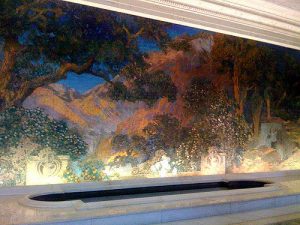Corning will display Tiffany glass mosaics
The name Louis Comfort Tiffany is virtually synonymous with stained glass. Tiffany was an artist whose career spanned the 19th and 20th centuries. He was most closely associated with the Art Nouveau movement, and worked with glass, jewelry, ceramics and metals. Although he is closely associated (by name) with Tiffany & Co., Louis Comfort Tiffany was actually the son of the company’s founder, Charles Lewis Tiffany.
Tiffany studied under George Innes and Samuel Colman as a painter. His early paintings were heavily influenced by French landscape painter Leon Belly. Despite his training as a painter, he became deeply interested in glass as an artistic medium, and formed a working relationship with several different artists in his late 20’s and early 30’s. Although that collective didn’t survive, while it was active, the artists developed practical artistic items like wallpaper and furniture.
Tiffany received important commissions to redesign or redecorate some high visibility residences, including the Mark Twain House and the White House under Chester A. Arthur. Tiffany used his own glass designs extensively in these commissions. Theodore Roosevelt, who advocated for interior designs that complemented the White House’s original architecture, removed much of Tiffany’s work on the White House during a later renovation.
Tiffany began to work exclusively with glass in the mid-1880’s. He often made his own glass to ensure that the glass contained the artistic properties he was looking for. He experimented extensively with colors, textures and techniques to achieve the iconic Tiffany look. In addition, Tiffany used copper foil in place of lead to connect colored glasses together into a unified piece.
While Tiffany was known for his lampshades, he also created artistic windows and room dividers that combined painted glass and stained glass. Tiffany built his own glass furnace and exhibited his works at high profile events, including the 1893 World’s Fair and the 1900 Exposition Universelle in Paris.
While most closely associated with his windows and lampshades, Tiffany also created glass mosaics, and had a dedicated mosaic workshop at his design and fabrication facilities. If you’ve never seen a Tiffany mosaic, you’re in luck. In May, the Corning Museum of Glass will open an exhibit displaying more than 50 of Tiffany’s mosaics. The mosaics employ some of Tiffany’s pioneering techniques, including the use of opalescent and iridescent glasses.
The mosaics are exceptionally colorful, vibrant and detailed. In addition to the mosaics themselves, the museum exhibit will also present design notes, samples and photographs, which will help the visitor to understand the exhaustive design and fabrication process used by Tiffany and his studio of more than 300 artists.
Tiffany’s mosaics, which are made up from multiple glass panels, aren’t limited to museums. Many of his original mosaics still survive, and are installed in private homes and commercial buildings around the country.
The museum exhibit will be available to the public from May 20, 2017-January 7, 2018.
Photo Credit: Gloria Bell, via Flickr.com

